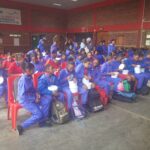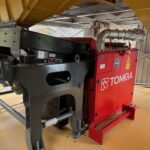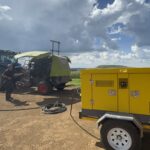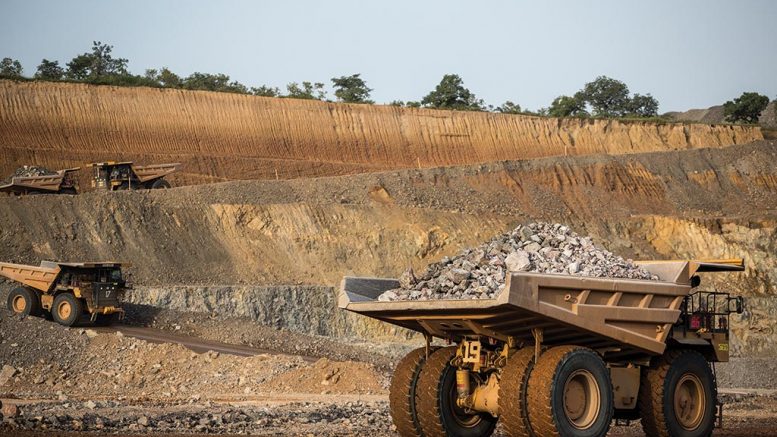Anthony Vaccaro, group publisher of The Northern Miner and head of global mining for Glacier Resource Innovation Group, opened the session by introducing Mark Child, chairman, and CEO of Condor Gold.
Condor is a junior gold exploration and development company with a focus on Nicaragua and Central America.
Child joined the board of Condor in May 2006 and became CEO in July 2011 and has over 20 years of equity capital markets experience.
Speaking from a rainy London in the United Kingdom, Child delivered a short presentation on the company’s flagship La India gold project, located approximately 100 km north of Nicaragua’s capital, Managua.
The property covers 588 sq. km and hosts the historic La India gold mine, which processed an estimated 1.7 million tonnes grading 13.4 grams gold per tonne for 576,000 oz. contained gold between 1938 and 1956.
The company is currently taking a twin approach to the development of the property, Child said.
Firstly, the company plans to construct a 2,800 tonne-a-day processing plant for a planned production of 100,000 oz. of gold annually. Secondly, it plans to expand the mineral resources by around 1 million oz. of gold and prove a significant gold district of 5 million oz. of gold.
“We have a preliminary feasibility study for 80,000 ounces of gold per year for a mine life of 7.5 years from a single open pit, with production expected to start in around 24 months,” Child said.
The project is permitted for over 1.12 million oz. of gold across three open pits: La India pit with potential for 900,000 oz. of gold grading 3.1 grams gold; Mestiza with 120,000 oz. of gold at 8.6 grams gold; and America with 97,000 oz. of gold at 3.8 grams gold.
All deposits have the potential to be extended along strike and down-dip, Child noted.
The project contains indicated resources of 9.85 million tonnes grading 3.6 grams gold for 1.14 million oz. of gold. Inferred resources add 8.48 million tonnes at 4.3 grams gold for 1.23 million oz. of gold.
“We’ve conducted around 84,000 metres of drilling with some great high-grade drill results, including over 10 metres at 34.79 grams from 173.15 metres,” Child said.
In parallel to the permitting process, the company has also been carrying out drill soil geochemistry, geophysics, structural modelling, scout drilling, and geological mapping, which has identified many drill targets.
Child then joined Vaccaro to discuss some new developments at the project.
Vaccaro began by asking about permitting at the property, in particular, several recently discovered satellite pits that have combined inferred resources of around 207,000 oz. of gold.
“It takes a good 12 months to get a permit in Nicaragua and requires the submission of 18 technical studies, with around 600-page studies for each of the feeder pits,” Child said.
Vaccaro noted that Condor had raised around $9 million in funding and asked how the company plans to spend the money.
“The Nicaraguan government has around ten conditions before you break ground, one of which is to engineer the tailings store fully,” Child said.
“There are mine schedule studies that have already completed, as well as processing plant designs that will be paid for with the money,” Child said.
The company, he added, aims to engineer the project as much as it can, clear as much of the land as possible, and purchase another processing plant.
The conversation wrapped up with Vaccaro asking Child about social engagement activities undertaken by the company in Nicaragua.
“We’ve been very active in engaging with the local communities,” Child said. “We have set-up elderly and youth engagement committees, pro-business committees, and artisanal mining-engagement plans, and also have a Nicaraguan mining day coming up in the next few weeks,” Child said.
Lisa Davis, CEO of PearTree Financial Services, then joined Vaccaro for a brief discussion about flow-through shares, in particular about traditional flow-through versus charitable flow-through.
PeerTree is a boutique financing and advisory firm focused on the junior Canadian resource sector. It has extensive experience in the investment industry, including over a decade focused on corporate finance to fund mineral exploration and development projects.
Vaccaro began with a question on whether non-Canadian companies can participate in the flow-through process.
“The projects are required to be in Canada,” Davis said, “but the company issuing the flow-through shares are not required to be a Canadian-registered corporation.”
However, there are specific requirements like the majority of their business must be focused on mineral exploration and mining, as well as other criteria that companies must meet, she added.
Vaccaro asked Davis if charitable donors were particularly selective about companies that they decide to invest in.
“For the most part, they are focused on specific tax considerations and generally put their faith in PearTree to conduct the required due diligence on companies,” Davis said.
However, she noted that some donors are more concerned about the nature of the company as a “larger market cap, for instance, might be something that interests them.”
Next, Vaccaro spoke with Christian Milau, CEO of Equinox Gold, a multi-asset mining company and, Vaccaro noted, one of the few companies with operations solely in the Americas.
Milau became CEO of Equinox in August 2016 and has led the company through three mergers and acquisitions and has grown the company from a single-asset developer to a multi-asset producer in just two years.
The company is producing gold from its Los Filos mine complex in Mexico, its Mesquite inme in California, and its Aurizona, Fazenda, RDM, and Pilar mines in Brazil. The company’s second California mine, Castle Mountain, is in construction with first gold pour targeted for the third quarter of this year.
After presenting a brief overview of its portfolio, Milau joined Vaccaro, who opened the conversation by asking him how the company came to be called Equinox.
“The management team was feeding various names around like ‘Solaris’, ‘The Sun,’ ‘The Moon’, and so ‘Equinox’ felt like a natural next step for us,” he said. “Also, we went to Ross [Beaty] and said, ‘how about Equinox Gold?’ He replied by saying his first company was called Equinox Resource, and so we went with the name.”
Beaty has invested more than US$120 million in Equinox since becoming executive chairman in November 2017 and, with a 9% interest in the company, is the largest individual shareholder.
Vaccaro then noted that with increased production from their mines and with gold currently sitting at around US$1,700 per ounce, would this lead to an acceleration in the timeline for paying-out dividends?
“I’ve been asked that question probably three or four times in the last couple of weeks in various marketing meetings,” Milau said. “Three or four months ago, I would have said ‘let’s just get this growth done over the next 18 months to two years to achieve steady growth before starting to pay dividends.’”
But with the current high gold price and forex rates and diesel prices so weak, he believes there is “a real possibility of paying a small dividend while the company is going through growth and capital expansion and could be factored into the company’s plans next year.”
However, Milau did not want to commit to this before gauging how the business environment plays out this year, given the Covid-19 pandemic.
Vaccaro finished by asking Milau if Equinox was still on the look-out for possible new mergers or acquisitions?
“We could sell one asset or even two small ones to refine the portfolio, so there isn’t the same urgency or need for scale anymore,” he noted. “However, we could add asset in another jurisdiction, or a long-life, lower-cost tier one- or tier two-type asset. So, I think we need to be open-minded about that.”
Rounding off Day 2 of the symposium, Vaccaro spoke with Clive Johnson, a founding shareholder of B2Gold, who has served as president, CEO, and a director of the company since its inception in November 2006.
Johnson has conducted exploration and gold mining in over 12 countries throughout his career, from northeast Russia to South Africa. Through his leadership roles in B2Gold and predecessor company, Bema Gold, Johnson is recognised for combining an entrepreneurial business approach with technical expertise.
He is also well known for his commitment to corporate social responsibility. He is a past recipient of both the Viola MacMillan Developer’s Award from the Prospectors and Developers Association of Canada and the Pacific Entrepreneur of the Year Award for Mining and Metals.
From ‘zero to one million ounces and raising the bar along the way’ was the theme of the conversation.
“When we say, ‘zero to one million ounces’ that’s the B2Gold story, but the Bema story in many ways is fundamental to what B2Gold became,” Vaccaro noted.
“By combing entrepreneurial drive, which you’re famous for in the industry, with technical expertise, you can do special things in the industry. Was that part of your thinking from the outset with Bema Gold or did it evolve?” Vaccaro asked.
“Well, I think it evolved,” Johnson replied. “I started in the mining and exploration business as a line cutter and claim sticker for a little company called Bema Industries as a summer job while I was at university.”
The company, he added, grew to become a successful contracting manufacturing company.
The company, he explained, then decided that rather than work on projects for other companies to support their own exploration, they would develop their projects with Bema Gold emerging from the merger of three junior companies in 1980.
Bema, Johnson said, was one of the first companies to successfully transition from an exploration company to a mine construction company and then to a production company.
“I would recommend most companies not to try this,” he added, “as they are very different businesses.”
However, by bringing in good development engineers like George Johnson and Tom Garrigan in the mid-90s, he explained that they were able to maintain their entrepreneurial spirit and technical expertise.
“We combined that entrepreneurial spirit with some of the best technical minds in the business and passed that on from Bema to B2Gold,” Johnson said. “Even though B2Gold was a brand-new company in 2007, we hit the ground running and within a decade went from zero ounces a year to 10 million ounces a year across four different countries.”
The conversation turned to the story behind Bema’s sale of the Kupol gold mine, located in the Bilibinsky district of the Chukotka Autonomous Okrug of Russia.
“At the time we went into Russia the markets were terrible, and a lot of bankers would say to me, ‘the two most negative investments in the world are gold and Russia,’” Johnson said. “And we had both.”
However, Johnson added, during their initial search for opportunities in Russia, they would ask “every Russian we met about prospects, and the name Kupol kept coming up.” After securing the rights to explore the place, “George [Johnson] turned to me and said, ‘we’ve got to get this one,’” he said.
Johnson then spoke about his experiences dealing with Ibrahim Abramovich, the Russian oil and gas billionaire and owner of Chelsea F.C. soccer club in London, England.
Abramovich, Johnson said, went to Chukotka looking for offshore oil and gas finds in the Bearing Sea, but was so disgusted by the poverty he saw there, he decided to become the district’s Governor.
“He invested around U$1.5 billion of his fortune to upgrade the area, building a hospital, houses, and a gas line because he saw the potential for oil and gas and mining in the region,” Johnson noted.
It was around this time, Johnson added, that they met with Abramovich, who, as governor of the district, had oversight of the permitting licenses for Kupol.
After meeting with Abramovich in Moscow, Abramovich told Johnson that he had no interest in the mine but wanted the economic value to come to Chukotka.
After demonstrating the potential value of Kupol to Abramovich, the company purchased it for US$100 million, with the Chukotka government taking a 25% stake.
“Kupol ended up becoming one of the most spectacular gold discoveries in the last 50 years,” Johnson said.
Kinross Gold (TSX: K; NYSE: KGC) took over the project when it acquired Bema and its 75% interest in Kupol for US$3.5 billion in 2007.
Key to the success of Kupol, Johnson emphasised, was “treating people with respect and delivering on your promises.”
B2Gold was founded after the sale of Bema to Kinross.
The success at Kupol led B2Gold to enter other jurisdictions, such as Nicaragua, Mali, and the Philippines, which many considered too risky.
“For 30-plus years, we’ve been more geologically driven that geographically driven, Johnson said. “That’s the benefit of having a team that will go just about anywhere to try to find a gold mine,” Johnson said.
By taking this approach, Johnson explained, they were able to identify and seize opportunities. The idea behind B2Gold, he added, was to acquire properties through acquisition as well as their exploration activities.
Johnson, for example, cites the Fekola mine in Mali, which the company acquired in 2014 and then “almost doubled the mineral resources to almost 8 million ounces of gold,” he said.
“So here we are now, [producing] a million ounces of gold a year at around US$800 per ounces in all-in sustaining costs and we’ll be net-debt free by the end of this month,” he said, “We’re looking to generate around US$850 million in cash from operations this year.”
The conversation then turned towards the impact of the Covid-19 pandemic. Vaccaro noted that even though the outbreak has led to the shuttering of mines around the world, B2Gold was still on guidance to achieve production of between 1 million to 1.25 million oz. of gold this year.
“It’s a remarkable success story, that’s not only to our credit but to the credit of our employees, the unions, and the governments of the countries that we operate in,” Johnson said.
Johnson noted that they built Fekola in 2015 while Mali was suffering from an outbreak of the deadly Ebola disease.
“The key factors are trust between the company, employees, and the government, and that’s where the years of treating people fairly and with transparency pay off,” he said.
For example, he noted that the company had a couple of employees test positive for Covid-19 at Fekola. In response, the company prevented people from leaving and entering the site and isolated those who tested positive.
“We’re now moving into full testing of everybody on-site, which has allowed us to keep morale up and to continue mining,” Johnson added. “Our approach has led to us having one of the lowest lost-time incident rates of any mining company in the world and has made us an industry leader in health and safety.”
The conversation then segued to B2Gold’s approach to Environmental and Social Governance (ESG), with Vaccaro noting how the company is trying to “raise the bar when it comes to ESG.”
“We’ve been big fans of ESG and CSR before they had fancy titles,” Johnson said, “and have always believed culturally, philosophically, and strategically that when you come into a country it must benefit the people in that country as well.”
The company, he added, has always tried to come up with new and innovative ways to work with local communities that result in a “win-win” outcome.
For example, he cited the time the company brought in a milk-chilling facility into their La Libertad mine in Nicaragua. And when the company helped rebuild coral reefs in the Philippines that were destroyed by fishermen using dynamite to catch fish.
B2Gold has also built a non-profit nature reserve in Namibia, Southern Africa, with the specific intention of saving the black rhino.
“Black rhinos are on the endangered species list, and Namibia is one of the few places in Africa where they still roam, he said. “But poaching over the years, particularly in 2015 and 2016, has significantly decreased their numbers,” he said.
“You try to do things that have a sustainable development element so that when the mine shuts down you’ve left a better place behind and that year on year, you try to do everything you can to raise the bar.”















